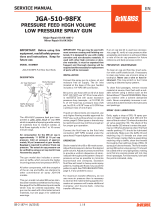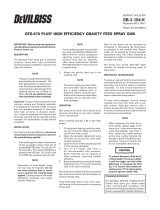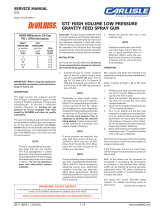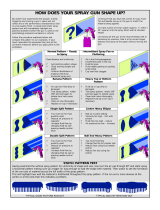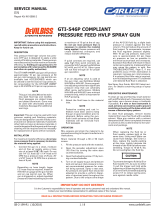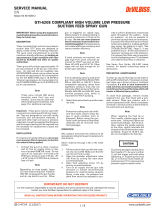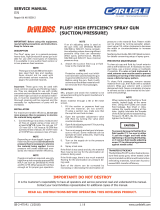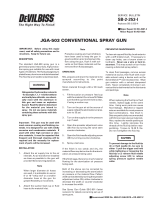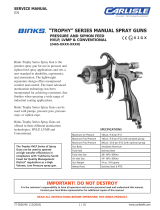Page is loading ...

EN
SB-2-179-G (8/2015) 1 / 8
SERVICE MANUAL
GFGTM GRAVITY PROTM MODEL GFG-517
CONVENTIONAL SPRAY GUN
DESCRIPTION
The GFG-517 is a general purpose, heavy
duty, high production spray gun suitable for
use with most types of materials. The fluid
tip and needle and internal fluid passages
are stainless steel.
Note
This gun includes 300 series
stainless steel fluid passages and
400/300 S.S. series tip and needle.
Guns may be used with chlorinated
solvent materials. The gravity cup
must also be compatible for use
with chlorinated solvent materials
(GFC-501 Acetal).
IMPORTANT: This gun is designed for use
with mildly corrosive and non-abrasive
materials. If used with other high corrosive
or abrasive materials, it must be expected
that frequent and thorough cleaning will be
required and the necessity for replacement
of parts will be increased.
Note
The GFC gravity feed cups are
included with the gun as part of
the GFG-618 gun and cup kits. See
Accessories on page 6 for more
information.
INSTALLATION
1. Attach the air supply line to the air
inlet (18). An air transformer installed
as close as possible to the gun will
provide filtered and regulated air.
Note
When larger diameter air hoses
are used, it is advisable to use an
8' or 10' "whip end" or a smaller di-
ameter hose at the gun for greater
flexibility or movement.
2. Attach the gravity feed cup to the
material inlet.
Note
Protective coating and rust inhibi-
tors have been used to keep the
gun in good condition prior to
shipment. Before using the gun,
flush it with solvents so that these
materials will be removed from
fluid passages.
OPERATION
Mix, prepare and strain the material to be
sprayed according to the paint manufac-
turer's instructions.
Strain material through a 60 or 90 mesh
screen.
1. Fill the gravity feed cup with the ma-
terial. Do not overfill. Make sure that
the cup lid vent hole is clear.
2. Turn on the air at the source of supply.
Adjust the atomization air pressure to
35 psi.
3. Open the spreader adjustment valve
(19) (Fan) by turning the valve stem
counter-clockwise.
4. Close the fluid needle adjusting screw
(25) by turning clockwise.
5. Spray a test area by turning the fluid
needle adjusting screw (25) counter-
clockwise until a full coat is obtained.
If the finish is too sandy and dry, the mate-
rial flow may be too low for the atomization
air pressure being used.
If the finish sags, there is too much material
flowing for the atomization air pressure
being used.
Both of the above can be corrected by in-
creasing or decreasing the atomization air
pressure or the material flow. Pattern width
can be altered by turning the spreader
adjustment valve (19), either clockwise to
decrease the width or counter-clockwise
to increase the width.
IMPORTANT: Before using this
equipment, read all safety precautions
and instructions. Keep for future use.
PREVENTIVE MAINTENANCE
To clean air cap and fluid tip, brush exterior
with a stiff bristle brush. If necessary to clean
cap holes, use a broom straw or toothpick.
Never use a wire or hard instrument. This
may scratch or burr holes causing a dis-
torted spray pattern.
To clean fluid passages, remove excess
material from cup, then flush with a suitable
solvent. Wipe gun exterior with a solvent
dampened cloth. Never completely im-
merse in solvent as this is detrimental to
the lubricants and packings.
Note
When replacing the fluid tip or fluid
needle, replace both at the same
time. Using worn parts can cause
fluid leakage. Tip and needle sets
are available. See Chart 2. Also,
replace the needle packing at this
time. Lightly lubricate the threads
of the fluid tip before reassembling.
Torque to 12-15 ft. lbs. Do not
overtighten the fluid tip.
To prevent damage to the fluid tip (2)
or fluid needle (2), be sure to either
1) pull the trigger and hold while
tightening or loosening the fluid tip
or 2) remove fluid needle adjusting
screw (25) to relieve spring pressure
against needle collar.
SPRAY GUN LUBRICATION
Daily, apply a drop of SSL-10* spray gun
lube at trigger bearing stud (15) and the
stem of the air valve (10) where it enters
the air valve assembly (13). The shank of
the fluid needle (2) where it enters the pack-
ing nut (6) should also be oiled. The fluid
needle packing (5) should be lubricated
periodically. Make sure the baffle (4) and
retaining ring (1) threads are clean and
free of foreign matter. Before assembling
retaining ring to baffle, clean the threads
thoroughly, then add two drops of SSL-10
spray gun lube to threads. The fluid needle
spring (22) and air valve spring (11) should
be coated with a very light grease, making
(Continued on page 3)

EN
SB-2-179-G (8/2015)2 / 8
Adequate exhaust must be provided to keep air free of
accumulations of flammable vapors.
Smoking must never be allowed in the spray area.
Fire extinguishing equipment must be present in the spray
area.
Wear eye protection.
Follow the requirements of the Material Safety Data Sheet
supplied by your coating material manufacturer.
Adequate exhaust must be provided to keep the air free of
accumulations of toxic materials.
Use a mask or respirator whenever there is a chance of
inhaling sprayed materials. The mask must be compatible
with the material being sprayed and its concentration.
Equipment must be as prescribed by an industrial hygienst
or safety expert, and be NIOSH approved.
Guns with stainless steel internal passageways may be used
with these solvents. However, aluminum is widely used
in other spray application equipment - such as material
pumps, regulators, valves, and cups. Check all equipment
items before use and make sure they can also be used safely
with these solvents. Read the label or data sheet for the
material you intend to spray. If in doubt as to whether or
not a coating or cleaning material is compatible, contact
your material supplier.
Operators should be given adequate training in the safe
use and maintenance of the equipment (in accordance
with the requirements of NFPA-33, Chapter 15). Users must
comply with all local and national codes of practice and
insurance company requirements governing ventilation, fire
precautions, operation, maintenance, and housekeeping.
These are OSHA Sections 1910.94 and 1910.107 and NFPA-
33. Risk is reduced by avoiding or lessening factors 1-7.
Solvent and coatings can be highly
flammable or combustible especially
when sprayed.
During use and while cleaning and
flushing, solvents can be forcefully
expelled from fluid and air passages.
Some solvents can cause eye injury.
Certain materials may be harmful if
inhaled, or if there is contact with the skin.
Halogenated hydrocarbon solvents - for
example; methylene chloride and 1,1,1,
- Trichloroethane are not chemically
compatible with the aluminum that might
be used in many system components.
The chemical reaction caused by these
solvents reacting with aluminum can
become violent and lead to an equipment
explosion.
Improper operation or maintenance of
equipment.
Fire
Solvent Spray
Inhaling Toxic Substances
Explosion Hazard -
Incompatible Materials
General Safety
Important information that tells how to
prevent damage to equipment, or how
to avoid a situation that may cause
minor injury.
NOTE
Information that you should pay
special attention to.
SAFETY PRECAUTIONS
This manual contains information that is important for you to know and understand. This information relates to USER SAFETY and
PREVENTING EQUIPMENT PROBLEMS. To help you recognize this information, we use the following symbols. Please pay particular
attention to these sections.
Important safety information - A hazard
that may cause serious injury or loss of life.
The following hazards may occur during the normal use of this equipment.
Please read the following chart before using this equipment.
HAZARD CAUSE SAFEGUARDS

EN
SB-2-179-G (8/2015) 3 / 8
Use of hand tools may casue cumulative
trauma disorders ("CTD's").
CTD's, when using hand tools, tend
to affect the upper extremities.
Factors which may increase the risk of
developing a CTD include:
1. High frequency of the activity.
2. Excessive force, such as gripping,
pinching, or pressing with the hands
and fingers.
3. Extreme or awkward finger, wrist, or
arm positions.
4. Excessive duration of the activity.
5. Tool vibration.
6. Repeated pressure on a body part.
7. Working in cold temperatures.
CTD's can also be caused by such
activities as sewing, golf, tennis, and
bowling, to name a few.
sure that any excess grease will not clog the
air passages. For best results, lubricate the
points indicated, daily.
*Not for air tools or high RPM equipment.
A. Trigger Points
B. Packing
C. Adjusting Valves
D. Baffle Threads
E. Air Valve Cartridge
HAZARD CAUSE SAFEGUARDS
PARTS REPLACEMENT
Replacement Instructions for O-ring on
Spreader Adjustment Valve
1. Remove retaining ring (20) on spreader
adjustment.
2. Remove valve stem and PTFE O-ring
(21) from valve body.
3. Insert new PTFE O-ring (21) in valve
body. Make sure it is pushed past the
threads.
4. Insert valve stem.
5. Reinstall retaining ring (20).
CHART 1
Air Caps
If This No. On Ref. No. 1 Air Cap
Cap, Order with Retaining Ring
No. 9000 AV-440-9000
No. 80 MB-4039-80
Cumulative Trauma
Disorders ("CTD's")
CTD's, or musculoskeletal
disorders, involve damage
to the hands, wrists,
elbows, shoulders, neck,
and back. Carpal tunnel
syndrome and tendonitis
(such as tennis elbow or
rotator cuff syndrome) are
examples of CTD's.
Pain, tingling, or numbness in the shoulder, forearm,
wrist, hands, or fingers, especially during the night, may
be early symptoms of a CTD. Do not ignore them. Should
you experience any such symptoms, see a physician
immediately. Other early symptoms may include vague
discomfort in the hand, loss of manual dexterity, and
nonspecific pain in the arm. Ignoring early symptoms and
continued repetitive use of the arm, wrist, and hand can
lead to serious disability.
CHART 2
Fluid Tips and Needles
GFG-517 Ref. #2
Tip Fluid Tip Size If This No. On Tip and
Size I.D. Dimensions Tip, Order Needle Sets
EX 0.070" 1.75 mm AV-2115-EX JGA-4040-EX
FW 0.063" 1.6 mm AV-2115-FW JGA-4040-FW
FF 0.055" 1.4 mm AV-2115-FF JGA-4040-FF
1. Remove fluid tip (2).
2. Remove baffle (4).
3. Remove seal (3) from baffle.
4. Assemble seal to baffle with angled
side up as shown at right.
NOTE
The seal should be a tight fit
on the baffle. If it is a loose fit
on the baffle, assure that it is
assembled with the angled
side up.
5. Install baffle on gun.
6. Install fluid tip (2) and tighten to
12-15 ft-lbs.
NOTE
The seal is designed to be a tight
fit on the baffle. The seal should
be able to be removed using your
fingers. If you are unable to re-
move the seal using your fingers,
insert a small screwdriver be-
tween the outer lip and the back
of the baffle and pry the seal off.
GTI-33 Baffle Seal Replacement (3) ANGLED SIDE
THICK SIDE
SEAL
BAFFLE
Pry here if
necessary
(Continued from page 1)

EN
SB-2-179-G (8/2015)4 / 8
PARTS LIST
Ref. Individual
No. Part No. Description Parts Req.
1 See Chart 1 Air Cap & Retaining Ring 1
2 See Chart 2 Lapped Fluid Tip and Needle 1
• 3 GTI-33-K5 Seal Kit (Kit of 5) 1
4 GTI-425 Baffle Assembly 1
•+ 5 JGV-463-K3 Fluid Needle Packing (Kit of 3) 1
6 34411-122-K10 Fluid Needle Packing Gland 1
(Kit of 10)
• 7 —— Snap Ring 1
• 8 —— Washer 1
•+ 9 —— U Cup 1
• 10 —— Air Valve 1
• 11 —— Spring 1
•+ 12 JGS-72-K10 Gasket (Kit of 10) (PTFE) 2
13 JGS-449-1 Air Valve Assembly 1
• 14 —— Screw 1
15 —— Trigger Bearing Stud 1
16 JGS-478 Stud and Screw Kit 1
(Kit includes 3 studs & 5 screws)
Detail Ref. No. 5 - Two piece packing
covered by U.S. Patent No. 5,209,501.
+ Tapered edge faces out towards packing
nut.
+Inner PTFE Piece
Fluid Packing Nut
Fluid Needle
Outer
U.H.M.W.
Poly. Piece
Ref. Individual
No. Part No. Description Parts Req.
17 JGS-477-1 Trigger, Stud and Screw Kit 1
(Kit includes 1 each)
18 P-MB-51 Air Inlet Connector 1/4" NPS(M) 1
19 GFG-413-2 Spreader Adjustment Valve 1
• 20 —— Retaining Ring 1
•+ 21 —— O-ring (PTFE) 1
• 22 MBD-19-K10 Fluid Needle Spring (Kit of 10) 1
• 23 —— Spring Pad (Included with #22) 1
24 —— Gun Body Bushing 1
25 GTI-414 Fluid Needle Adjusting Screw 1
26 JGA-4041 Bushing, Spring & Knob Kit 1
27 6000-12 Plug 1
28 GFG-6 Gun Hook 1
• KK-5025 Gun Repair Kit includes a quantity of necessary parts
and should be kept on hand for service convenience.
+ KK-5036 Soft Gun Repair Kit includes a quantity of necessary
parts.
Suffixes - K5, K10 designate kits of multiple parts.
(Example) GTI-33-K5 is a kit of 5 seals.
1
2
Torque to
12-15 ft. lbs.
4
3
6
12
11
10
9
8
713
15
14
16
17
18 (1/4 NPS(M)
*Apply Loctite #242
(Blue) to threads and
torque to 15 ft. lbs.
20
21
19 (Spreader
Adjustment)
28
2
22
26
23
12
24
25
19
(Accessory)
21
20
27
5
See GTI-33 Baffle Seal
Replacement instructions
on page 3.

EN
SB-2-179-G (8/2015) 5 / 8
Heavy top or
bottom pattern
Heavy right or left
side pattern
Heavy center pattern
Split spray pattern
Jerky or fluttering spray
Unable to get round spray
Will not spray
Paint bubbles in cup
Fluid leaking or dripping from
cup lid
Starved spray pattern
Excessive overspray
Excessive fog
Dry spray
Fluid leaking from packing nut
Fluid leaking or dripping from
front of gun
TROUBLESHOOTING
CONDITION CAUSE CORRECTION
Horn holes plugged.
Obstruction on top or bottom of fluid tip.
Cap and/or tip seat dirty.
Left or right side horn holes plugged.
Dirt on left or right side of fluid tip.
Remedies for the top-heavy, bottom-heavy, right-heavy, and left-heavy patterns:
1. Determine if the obstruction is on the air cap or the fluid tip. Do this by making a test spray
pattern. Then, rotate the cap one-half turn and spray another pattern. If the defect is inverted,
obstruction is on the air cap. Clean the air cap as previously instructed.
2. If the defect is not inverted, it is on the fluid tip. Check for a fine burr on the edge of the fluid
tip. Remove with #600 wet or dry sand paper.
3. Check for dried paint just inside the opening; remove by washing with solvent.
Clean. Ream with non-metallic point.
Clean.
Clean.
Clean. Ream with non-metallic point.
Clean.
Fluid flow too high for atomization air.
Material flow exceeds air cap's capacity.
Spreader adjustment valve set too low.
Atomizing pressure too low.
Material too thick.
Atomization air pressure too high.
Fluid flow too low.
Spreader adjusting valve set too high.
*Loose or damaged fluid tip/seat.
Material level too low.
Container tipped too far.
Obstruction in fluid passage.
Dry or loose fluid needle packing nut.
Spreader adjustment screw not seating
properly.
Air cap retaining ring loose.
No air pressure at gun.
Fluid needle adjusting screw not open enough.
Fluid too heavy for gravity feed.
Fluid tip not tight.
Cup lid loose.
Dirty threads on cup or lid.
Cracked cup or lid.
Inadequate material flow.
Low atomization air pressure.
Too much atomization air pressure.
Gun too far from work surface.
Improper stroking (arcing, gun motion too
fast).
Too much or too fast-drying thinner.
Too much atomization air pressure.
Air pressure too high.
Gun tip too far from work surface.
Gun motion too fast.
Gun out of adjustment.
Packing nut loose.
Packing worn or dry.
Packing nut too tight.
Dry packing.
Fluid tip or needle worn or damaged.
Foreign matter in tip.
Fluid needle spring broken.
Wrong size needle or tip.
Balance air pressure and fluid flow. Increase
spray pattern width with spreader adjustment
valve.
Thin or lower fluid flow.
Adjust.
Increase pressure.
Thin to proper consistency.
Reduce at transformer or gun.
Increase fluid flow (increases gun handling speed).
Adjust.
Tighten or replace.
Refill.
Hold more upright.
Backflush with solvent.
Lubricate or tighten.
Clean or replace.
Tighten.
Check air supply and air lines, blow out gun air
passages.
Open fluid needle adjusting screw.
Thin material and/or change to larger tip size.
Tighten tip to 20-25 ft-lbs.
Tight lid.
Clean.
Replace cup and lid.
Back fluid adjusting screw out to first thread,
or change to larger tip size.
Increase air pressure and rebalance gun.
Reduce pressure.
Adjust to proper distance.
Move at moderate pace, parallel to work
surface.
Remix properly.
Reduce pressure.
Reduce air pressure.
Adjust to proper distance.
Slow down.
Adjust.
Tighten, do not bind needle.
Replace or lubricate.
Adjust.
Lubricate.
Replace tip and needle with lapped sets.
Clean.
Replace.
Replace.
*Most common problem.

EN
SB-2-179-G (8/2015)6 / 8
TROUBLESHOOTING (Continued)
CONDITION CAUSE CORRECTION
Fluid dripping or leaking from
bottom of cup
Runs and sags
Thin, sandy coarse finish drying
before it flows out
Thick, dimpled finish "orange
peel"
Cup loose on gun.
Washer worn or missing below cup.
Cup threads dirty.
Too much material flow.
Material too thin.
Gun tilted on an angle, or gun motion too
slow.
Gun too far from surface.
Too much air pressure.
Improper thinner being used.
Gun too close to surface.
Air pressure too low.
Improper thinner being used.
Material not properly mixed.
Surface rough, oily, dirty.
Tighten.
Replace washer.
Clean.
Adjust gun or reduce fluid flow.
Mix properly or apply light coats.
Hold gun at right angle to work and adapt to
proper gun technique.
Check distance. Normally approx. 8".
Reduce air pressure and check spray pattern.
Follow paint manufacturer's mixing instrs.
Check distance. Normally approx. 8".
Too much material coarsely atomized.
Increase air pressure or reduce fluid flow.
Follow paint manufacturer's mixing instrs.
Follow paint manufacturer's mixing instrs.
Properly clean and prepare.
NOTES

EN
SB-2-179-G (8/2015) 7 / 8
42884-214-K5 3/8"
42884-215-K10 5/8"
Cleaning Brushes
These brushes are
helpful in cleaning
threads and recesses
of gun body.
GFG-413-2 Air Ad-
justment Valve
Installs into
gun to enable
user to control
and reduce air
pressure at the
gun. Replaces
6000-12 plug.
HARG-510
Air Regulator
Use to maintain
nearly constant
outlet pressure de-
spite changes in
inlet pressure and
downstream flow.
WR-103 Wrench
Contains all neces-
sary tip, hose, and
nut sizes used on
or with gun.
HAV-500 OR
HAV-501
Adjusting Valve
(HAV-501 SHOWN)
HAV-500 does not
have pressure gage.
Use to control air
pessure at gun.
Spray Gun Lube
SSL-10-K12
(2 oz. bottle)
Compatible with
all paint materials;
contains no silicone
or petroleum distil-
lates to contaminate
paint.
GH-407 Gun Holder
(1) Wall mount
bracket included
with GH-407.
GH-505 Gun Holder
Gun holders are
made to hold stan-
dard paint cups,
gravity feed guns
and cups, and paint
filters.
GFC-501 (Acetal) 20 Oz. Cup
GFC-502 (Aluminum) 1 Liter
Gravity Feed Cups
Joins any single piece Devilbiss air cap
with latest version MBC-368 or MSA-1
retaining ring,. Helps prevent parts loss
and provides easier assembly.
JGA-156-K10 Spring Clips
These gravity feed cups are designed
to be used with GFG gravity feed
spray guns.
ACCESSORIES
Spray Gun and Cup Kits
GFG-517 Spray Gun is also sold in the follow-
ing Kits: Each Kits includes (1) GFG-517
Spray Gun and (1) GFG-502 Cup:
GFG-618-80FW GFG-618-90FF
GFG-618-90FW
OMX-70-K48 PAINT CUP LINER KIT
Allows quick and easy clean-up.
Consists of : 1 - Piercing Tool,
48 - Disposable Liners,
48 - Drain Bushings
HAF-507 Whirlwind™
In-Line Air Filter
Removes water, oil, and
debris from the air line.
Quick Disconnect Approved For
HVLP Guns (Air)
High Flow Ball and Ring Type.
HC-4700
1/4" NPT(F)
HC-4699
1/4" NPT(M)
HC-4419
1/4" NPS(F)
HC-1166
1/4" NPT(M)
Scrubs® are a pre-moistened
hand cleaner towel for painters.
No water is needed.
29-3100 Scrubs® Hand
Cleaner Towels

EN
SB-2-179-G (8/2015)8 / 8
Finishing Brands reserves the right to modify equipment specications without prior notice.
DeVilbiss®, Ransburg®, BGK®, and Binks® are registered trademarks of Carlisle Fluid Technologies, Inc.,
dba Finishing Brands. ©2015 Carlisle Fluid Technologies, Inc., dba Finishing Brands. All rights reserved.
WARRANTY POLICY
DeVilbiss products are covered by Finishing Brands one year materials and workmanship limited warranty.
The use of any parts or accessories, from a source other than Finishing Brands, will void all warranties.
For specic warranty information please contact the closest Finishing Brands location listed below.
DeVilbiss is part of Finishing Brands, a global leader in innovative spray nishing
technologies. For technical assistance or to locate an authorized distributor,
contact one of our international sales and customer support locations below.
USA/Canada
www.devilbiss.com
Tel: 1-800-992-4657
Fax: 1-888-246-5732
United Kingdom
www.nishingbrands.eu
Tel: +44 (0)1202 571 111
Fax: +44 (0)1202 573 488
China
www.nishingbrands.com.cn
Tel: +8621-3373 0108
Fax: +8621-3373 0308
Mexico
www.carlisleft.com.mx
Tel: 011 52 55 5321 2300
Fax: 011 52 55 5310 4790
France
www.nishingbrands.eu
Tel: +33(0)475 75 27 00
Fax: +33(0)475 75 27 59
Japan
www.ransburg.co.jp
Tel: 081 45 785 6421
Fax: 081 45 785 6517
Brazil
www.devilbiss.com.br
Tel: +55 11 5641 2776
Fax: 55 11 5641 1256
Germany
www.nishingbrands.eu
Tel: +49 (0) 6074 403 1
Fax: +49 (0) 6074 403 281
Australia
www.nishingbrands.com.au
Tel: +61 (0) 2 8525 7555
Fax: +61 (0) 2 8525 7500
/
